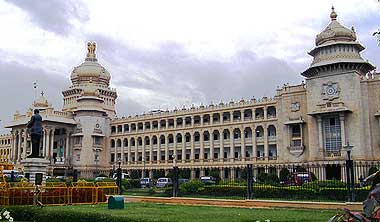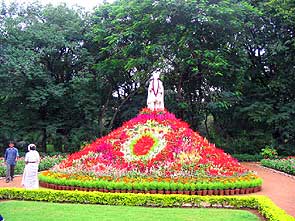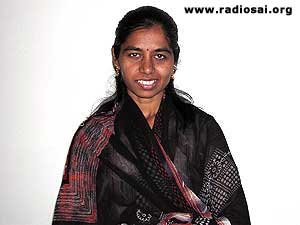 |
 |
 |
Volume
5 - Issue 02 FEBRUARY 2007
|
|
DAWN…AFTER A LONG DARK NIGHT! By Sri Y. Arvind Tanjore Painting – Rich and Special
Tanjore or Thanjavur as it is called today acquired its name from the ancient pronunciation of the place which was then called Thanjavoor. It was then the capital of the mighty Chola empire. The Chola rulers besides being great warriors, were builders of magnificent temples and great patrons of arts. It was against this setting that a highly specialized form of painting, with its characteristically beautiful ornamental relief work, flourished. These paintings are known for their elegance, rich colours, and attention to detail. The paintings are notable for their adornment in the form of semi-precious stones, pearls, glass pieces and gold. Crafted with meticulous care the Thanjavoor (Tanjore) pictures are unique. What sets them apart from Indian paintings in general are the embellishments made over the basic drawings with precious and semi-precious stones as well as the relief work which gives them a three dimensional effect. The pictures are of various sizes, ranging from huge works spanning whole walls to small miniatures no longer than 6-inch square. Bangalore – A Beautiful Blend of Cultures It must be evident from the above précis that Tanjore painting is an art that involves dexterity, imagination, creativity and a lot of patience. It is not an art for the ones who live in the hustle and bustle of a world of business lunches and deadlines. Malini T.P.S, the youngest daughter of late Mr. T.P Subbaiah and Mrs Padmavati, hailing from the city of Bangalore is learning this ancient art. Bangalore itself has a hoary past and the presence of this art form in this city is not a surprise. A brief look at the history of Bangalore will suffice to show how various cultures intermingled in the course of time. An inscription in stone found near Begur reveals, that the district was part of the Ganga kingdom ruled from Gangavadi until 1004 and was known as 'Benga-val-oru', the City of Guards in old Kannada. From the Gangavadi kingdom, the land passed into the hands of the Cholas. The Hoysalas ruled after the cholas until the establishment of the Vijayanagara empire. Modern Bangalore was founded by a feudatory of the Vijayanagara Empire, Kempe Gowda I. The city as it is known today was named by him. Later captured and ruled successively by the Marathas under the Adilshahi sultans, the Mughals, the Wodeyars, Hyder Ali and his son, Tipu Sultan and then Wodeyars again under The British East India Company until independence in 1947.
Most of the civic development of Bangalore was done after the plague crisis of 1898. Sanitation improved, and in turn, improvements in sanitation and health facilities helped to modernize Bangalore. Telephone lines were laid to help coordinate anti-plague operations. Regulations for building new houses with proper sanitation facilities came into effect. The city was divided into four wards for better coordination and the Victoria Hospital was inaugurated in 1900 by Lord Curzon, the then Viceroy and Governor-General of British India. In 1906, Bangalore became the first city in Asia to have electricity, supplied by the hydroelectric plant situated in Shivanasamudra. Prior to developments in the last few decades, Bangalore was a well laid out city with many spacious gardens, which provided it the moniker, the Garden City. Malini’s Malady
So, cultures have influenced each other, but fundamentally all are born from the minds of men. As a philosopher once said, “every great thing that ever happened to mankind began as a single thought in someone’s mind.” But then one has to dare to dream. The fear of failure is the biggest stumbling block in human initiative. But that was not the case with Malini. She did a one-year course at the Chitrakala Parishat of Karnataka in Tajore painting. She is now going to embark on a new journey. A journey with a companion of a lifetime…on January 27, 2006 she married the man of her dreams and is now moving to Gujarat. One would wonder why so much ado is being made of a young lady from Bangalore, who has learnt the difficult art of Tanjore painting and is newly married. Well! It would definitely seem a run of the mill story except for the fact that Malini, the young lady in context, was a patient of Chronic Temporal Lobe Epilepsy (fits) for three decades of her life! Born and brought up in this city, Malini was fortunate to be the youngest in the family. She has one elder brother and four elder sisters to look up to. All would have been well had she not been a victim of Temporal Lobe Epilepsy (TLE). She had the history of seizures when she was ten months old. Her parents took her to NIMANS (National Institute of Mental Health and Neuro Sciences) and other private nursing homes that gave treatment for seizures. She had spent around Rs. 25,000 on various forms of diagnostic tests and medicines. She had no idea how much more it would cost. Since it was an ongoing process of medical management, no amount had been fixed. Her father, an employee of Glaxo (a Pharma company), breathed his last in 1982. This was a tremendous blow to the ailing child. Her mother was working for a short period in NGEF (New Government Electrical Factory), but had to give up after demise of her father. Her family had to struggle hard to make ends meet. When God closes a door, he opens a window. Fortunately, all her sisters and brother got married without any problems and were settled in life, but the agony continued for Malini. She had to discontinue her education from her 9th standard on, since her fits were too violent to be controlled in school. Notwithstanding this, she took up fine arts and her interest led her in the direction of Tanjore painting. The decision is, in itself, a refection of her will and “never say die” attitude to life. SSSIHMS Provides Options…of Hope and Health
She visited the specialists at NIMHANS and was advised medication. The drugs were of no avail, since they were only palliative. She came to know about Baba’s Hospital in Bangalore only in the year 2004 through a poly clinic at Girinagar, Bangalore. The news that there existed a place where her malady could be cured absolutely free of cost came to her as manna from heaven. With economic help from her family she came to the SSSIHMS Whitefield. She had no expectations from the SSSIHMS till she came, saw and was admitted into its portals. The very sight of the Hospital filled her with hope: a Hospital that looks like a temple? Could this be the answer to her prayers? She was accompanied by her mother who stayed with her through out the treatment. A Plan for Treating Her Brain She was first admitted in December 4 for investigation and again after detailed investigation and study, she was admitted for the operation under the guidance of Dr. Geetha Rangan. She found the treatment plan explained to her very clearly. There was no ambiguity as to the surgical procedure she was to undergo and the medication she was to take before and after the surgery. Her final diagnosis as on March 25, 2005 read, Left Mesial Temporal Sclerosis (LMTS). The diagnostic procedures included MRI scans, EEG and Spect scans. Through the video EEG the doctors were able to diagnose that the seizures were emanating from a disorder of the left temporal lobe. The brain is still a medical frontier that human beings with all technology at their fingertips are yet to breach. And to those of us who are not very much in the know…here is a small note on how important “small” things are in the “big” scheme of things. Normal Brain Workings The brain primarily consists of the Cerbrum, Cerebellum and the Medulla Oblongata which extends down into the spinal cord. The brain is in two halves called hemispheres – the gap between the two halves is called the Slyvian fissure. Each of these areas of the brain is unique to a particular function of the human body and to date many areas have been mapped to their corresponding functions. The temporal lobe – the dysfunctional one in Malini’s case – is the lower horizontal lobe of either cerebral hemisphere, located in front of the occipital lobe and containing the sensory center of hearing in the brain.
Temporal lobes are part of the cerebrum. They lie at the sides of the brain, beneath the lateral or Sylvian fissure. Seen in profile, the human brain looks something like a boxing glove. The temporal lobes are where the thumbs would be. Behind the temporal lobes is the occipital lobe, where visual information first reaches the cortex. This part of the cortex (primary auditory cortex) is involved in hearing. Adjacent areas in the superior, posterior and lateral parts of the temporal lobes are involved in high-level auditory processing. In humans this includes speech, for which the left temporal lobe in particular seems to be specialized. The functions of the left temporal lobe are not limited to low-level perception but extend to comprehension, naming, verbal memory and other language functions. The underside of the temporal area appears to be involved in high-level visual processing of complex stimuli such as faces and scenes. The front of this tissue for visual processing is involved in object perception and recognition. The medial temporal lobes (near the sagittal plane that divides left and right cerebral hemispheres) are thought to be involved in episodic/declarative memory. Deep inside the medial temporal lobes, the hippocampi seem to be particularly important for memory function - particularly transference from short to long term memory and controlling spatial memory and behavior. All this would be Greek to even the educated, but then it suffices to say that the temporal lobes play a very important role in our interface with the world outside. So any dysfunction will have serious physical symptoms in the form of ‘seizures’ or ‘fits’ and the technical name given for this condition is Temporal Lobe Epilepsy. (TLE) Temporal Lobe Epilepsy Temporal lobe epilepsy (TLE) is a term that refers to a condition where seizures are generated in the portion of the brain called the temporal lobe. Either the right or the left temporal lobe can be involved, and in rare cases both temporal lobes can be involved in a particular individual. Under the broad category of TLE, there are a number of specific types. Malini was suffering from the mesial type (MTLE), there are characteristic abnormalities in the mesial aspect of the temporal lobe. The treatment goal of any epilepsy is freedom from seizures with no side-effects of medications. Although this is the goal, it is frequently not attained. In mesial TLE, medications frequently fail to adequately control the seizures. Fortunately, this particular epilepsy is most responsive to surgical treatment. The surgery for mesial TLE offers up to an 80% chance of cure and involves the removal of a portion of the affected temporal lobe. Malini’s Miraculous Recovery
A Left temporal lobectomy was performed on Malini on the fourth of February 2005. Post operatively, she didn’t have any seizure recurrence. She was on antiepileptics (seizure prevention drugs). Sutures were removed on 8th post operative day and the Wound was clean and healthy. She was in the hospital for the usual post operative recovery period. She did not have any untoward incidents in her recovery and had no neurological deficit whatsoever. Before she underwent surgery she had a very poor outlook towards life, because long-standing, poorly controlled epilepsy has a number of psychosocial ramifications. These can include (but are not limited to) memory difficulty, reduced self-esteem, depression, reduced ability for gainful employment, and greater difficulty with interpersonal relationships. All these disappeared after the surgery. She is now not just cured, but “healed” in both the clinical and esoteric sense of the expression. The ultimate aim of a clinical procedure is “to give the patient a better quality of life”. Malini received this gift at the temple of healing, The SSSIHMS Whitefield. She never dreamt of getting such good and free treatment in this hospital. “It is really amazing how all patients are getting free treatment without spending a rupee,” she says. She feels that she would not get similar service and attention if she had paid even in reputed nursing homes. To her joy, so far not a single instance of seizure has occurred. Beginning a New Life Appearances can be deceptive. And what is apparent is not necessarily inherent. From the ebullient smile of Malini and the well lined care worn visage of her mother, one can learn lessons of life. To be firm in the face of all adversity and never to give up hope. Every cloud has a silver lining and every dusk is followed by a dawn. To those of us who lead our lives ephemerally, floating on the surface of this ocean of life, let us remind ourselves that still waters run deep. There is much more to everything…we only have to look past the smiles…we understand what pain went into creating those expressions of joy. Pleasure is an interval between two pains – this also means that pain is an interval between two pleasures. Hard work definitely bears fruit, so does patience and forbearance. Let us learn from the life of Malini these lessons. As the poet Longfellow wrote in the concluding lines of his psalm of life, Let us then be up and doing,
With a heart for any fate; Still achieving, still pursuing, Learn to labor and to wait.
|
|
| You can write to us at : h2h@radiosai.org |
Vol 5 Issue 02 - FEBRAURY 2007
|
Best viewed in Internet Explorer - 1024 x 768 resolution. |







